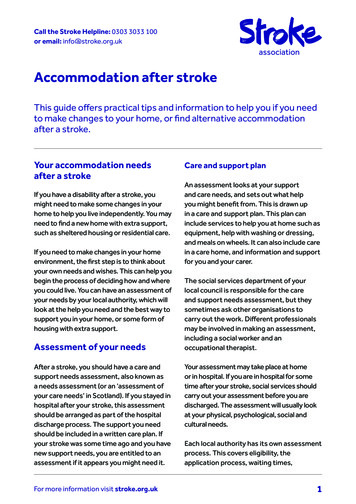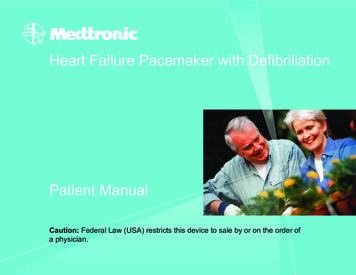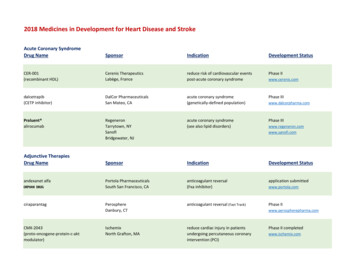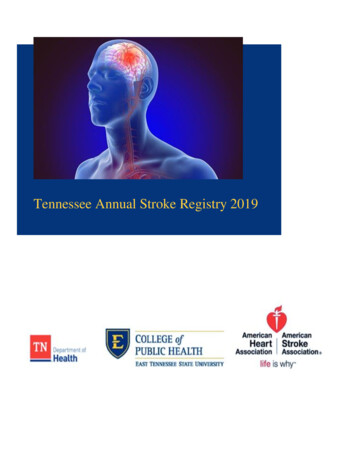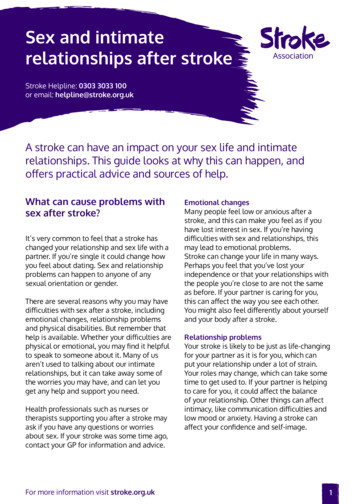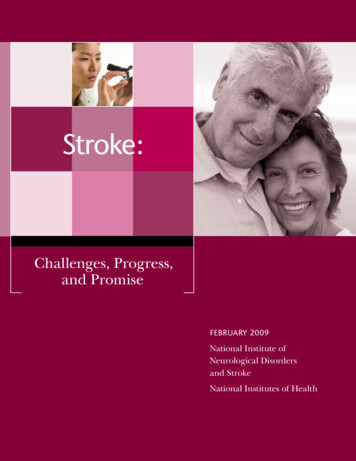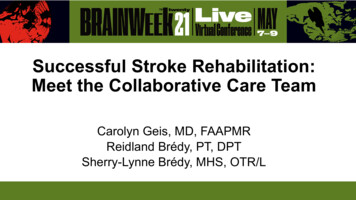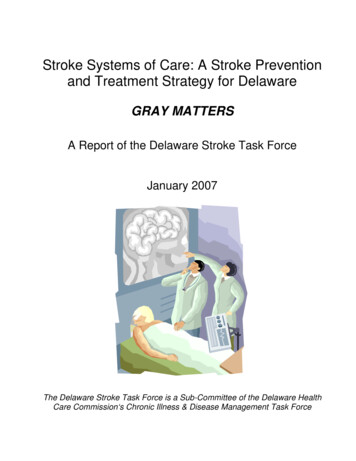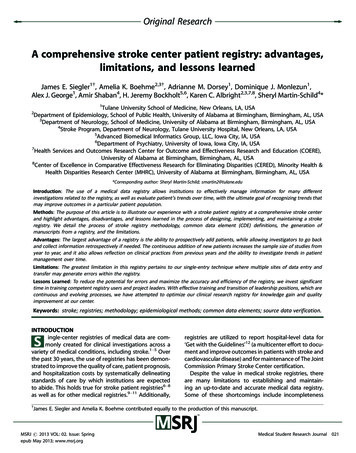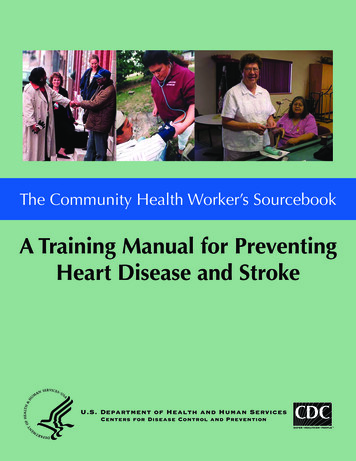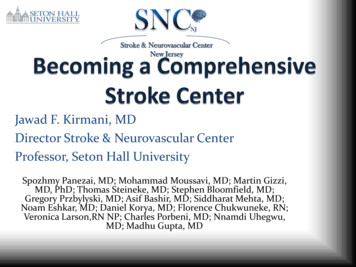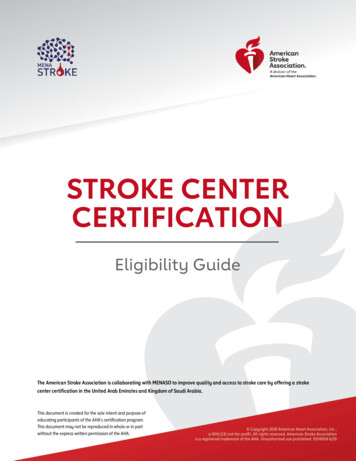
Transcription
STROKE CENTERCERTIFICATIONEligibility GuideThe American Stroke Association is collaborating with MENASO to improve quality and access to stroke care by offering a strokecenter certification in the United Arab Emirates and Kingdom of Saudi Arabia.This document is created for the sole intent and purpose ofeducating participants of the AHA’s certification program.This document may not be reproduced in whole or in partwithout the express written permission of the AHA.
STROKE CENTER CERTIFICATION Eligibility GuideIntroductionThe American Stroke Association (ASA) and the Middle East and North Africa StrokeOrganization (MENASO) share the belief that healthcare facility certification has greatpotential to improve the assessment, diagnosis, and treatment of stroke. In order to maximizethis benefit, certification must adhere to and reflect the latest clinical science and evidencebased guidelines that meet the current standards. As a public trust, these standards aredeveloped independently and overseen by mission-driven organizations with the clinicalbackground required to fulfill this trust by focusing on patient-centered quality healthcare,safety and value. Aligned in this purpose, ASA and MENASO are uniquely positioned to buildupon our shared leadership in translating guidelines into programs and services that shapeclinical care and improve patient outcomes to offer a comprehensive set of stroke certificationservices for health care facilities in the Middle East and North Africa region.Certification OverviewWe believe that hospitals and the patients theyserve benefit from a coordinated certificationprogram that provides enhanced value byenriching ASA’s approach quality improvementand certification. The overarching goals of thecertified Stroke Centers encompasses the patient,provider, enhancing the relationship with localhospitals, pre-hospital providers, governmentalhealth organizations, and engagement withinsurers and payors. The Certification is focusedon standardizing stroke patient care and isdesigned to evaluate each hospital against aprofessional set of criteria based ondemonstrated adherence to key standards and arigorous review process.The goals of the program are to: Ensure standardized care is driving decisionmaking at all levels represented in the strokecare environment Provide guidance and leadership onmeasurably improving stroke carecoordination and communication betweenand among care providersDemonstrate that high levels of compliancethrough certification or recognition results inmeasurable improvements in clinical qualityof care and cost effectivenessEligibility Guide Provides a framework focusing on evidencebased care to improve patient outcomes Assists organizations in establishing aconsistent approach to care, reducingvariations in care and the risk of errors Designation for excellence in the care ofstroke patients Facilitates the development of a loyal,cohesive, and highly competent clinical team Demonstrates commitment to a higherstandard of clinical service Differentiate in the market May fulfill regulatory requirements 2020 American Heart Association. All Rights Reserved3 Page3
STROKE CENTER CERTIFICATION Eligibility GuideBenefits for Patients Provide patients with access to centers focusedon stroke care Provide patients with confidence that thecenters can provide the most effective acutestroke treatment strategies Provide patients with assurance that the centerhas been vetted and is recognized by theAmerican Heart Association/ American StrokeAssociation, based on professional evaluationcriteria designed by international expertsBenefits for Certified FacilitiesPrimary Stroke Center Certification Ability to care for patients with acute ischemic stroke Rapid assessment, imaging, ability to administer intravenous thrombolytic therapy. Have the infrastructure to manage acute stroke patients in their facility. Interdisciplinary team availability to meet the medical, recovery, and social needs tothe stroke patient. Transfer protocols with a Comprehensive Stroke Center to care for medicallycomplex stroke patients, patients requiring interventions, and neurosurgicalemergencies for patients with either ischemic or hemorrhagic strokes. Stroke specific educational requirements for all disciplines caring for strokepatients. Data collection and interval submission of data. Robust stroke quality improvement initiatives.Comprehensive Stroke Center CertificationAbility to meet concurrently emerging needs of multiple complex stroke patients: Advanced imaging (CTA, MRI/MRA) 24/7 availability of neurosurgical services, including ability to clip and coilaneurysms (and meet volume requirements for clipping and coiling of aneurysmsand treatment of SAH due to aneurysm). 24/7 thrombectomy availability. Participate in IRB approved research. Increased education requirements for multidisciplinary staff. Collaborative management of patients with emergency medicine, neurology,neurosurgery, and vascular surgery (and other specialties as necessary).Eligibility Guide 2020 American Heart Association. All Rights Reserved4 Page4
STROKE CENTER CERTIFICATION Eligibility GuideData Burden ReductionCertification measures has data elementsincorporated in ASA’s Get With The Guidelines –Stroke registry as well as RES-Q and SITSregistries to decrease your data burden andfree up your resources, making yourcertification easier to achieve.Certification StandardsContact middle.east@heart.org or complete the information form on our website to request a copyof the detailed Stroke Center Certification Program Manual.Certification TermStroke Centers are each certified for a term of three years with an annual reviewprocess.FeesThe annual fee for Stroke Center Certification is 25,000 USD, which includes full participation in GetWith The Guidelines-Stroke quality improvement registry.Invoices are sent to the applicant once the Participation Agreement is fully executed. Payment must beremitted for the review process to begin. Please follow the instructions on the invoice to submit payment.Facilities have one year from payment date to complete the certification process. All payments are nonrefundable.Stroke Center Certification Eligibility Criteria The program uses a standardized method of delivering clinical care based on current evidencebased guidelinesThe program uses stroke performance measurement to improve its performance over timeThe facility participates in Get With The Guidelines or equivalent registry such as SITS or RES-QRequirementPrimary StrokeCenterComprehensive StrokeCenter InfrastructureStroke UnitIntensive Care UnitOperating room staffed 24/7Interventional service coverage 24/7Stroke registryEligibility Guide (if performing neurosurgicalprocedures) (if performing mechanicalthrombectomy procedures) 2020 American Heart Association. All Rights Reserved 5 Page5
STROKE CENTER CERTIFICATION Eligibility GuideResearch programCommunity educationProfessional education / Training ProgramThe facility has a charting system/consolidatedrecord in place that allows for information to beaccessible 24/7 by all team membersStaffingStroke Program DirectorAcute Stroke Team 24/7Interdisciplinary teamNeurology 24/7Neurosurgeon 24/7Vascular surgeryDiagnostic radiology/neuroradiology 24/7Interventional/endovascular physician(s) 24/7Critical Care MedicineRehabilitationRehabilitation therapy (physical, occupational,speech therapy)Respiratory TherapyAnnual Volume RequirementsSAH cases per yearEndovascular coiling or microsurgical clipping peryearIV thrombolytic cases per yearMechanical thrombectomies per yearDiagnostic TechniquesCT 24/7CTAMRI with diffusion*PSCs are recommended to have MRI, MRA, or CTAMRA/MRVDigital cerebral angiographyCarotid duplex U/STransthoracic echoTransesophageal echoSurgical and interventional therapiesCEAClipping of intracranial aneurysmPlacement of ventriculostomyHematoma removal/drainingPlacement of intracranial pressure transducerEndovascular ablation of IAs/AVMsIA reperfusion therapyEndovascular Rx of vasospasmLaboratoryEligibility Guide 1515102510 2020 American Heart Association. All Rights Reserved 6 Page6
STROKE CENTER CERTIFICATION Eligibility GuideCertification Process1. Eligibility Information and Requirements: Review the eligibility information contained in thisdocument.2. Request Standards: On the AHA webpage at http://www.heart.org/internationalQI. Complete andsubmit the requested information. Upon receipt of the request, an ASA representative will provide anelectronic copy of the comprehensive certification program manual, which includes the standards,measurement criteria, application, and the participation agreement.3. Application: The organization completes and submits the application located in the program manual.Applications will expire one year from the date received.4. Participation Agreement: The facility reviews, signs, and submits the agreement5. Fees: Once payment is received you will be contacted by an ASA Representative to initiate thecertification review process.6. Certification Readiness Review: ASA staff will work closely with the hospital to prepare for certificationreview. ASA staff helps you meet your stroke program goals through ongoing collaboration withmultidisciplinary team to improve patient care and outcomes. This includes but is not limited to sitepreparation to help your hospital prepare for certificationreview.7. Desk Review: A Reviewer evaluates the facilities’application and supporting documentation for adherenceto the Requirements. If there are any questions, theReviewer schedules calls with the facility to resolvedocumentation questions.8. Virtual Review: The virtual review will culminate with avirtual presentation of your hospital’s stroke program withReviewers. This is an opportunity for the Reviewers to have acomplete understanding of your program and learn abouthow you serve your stroke community. The Reviewers willprovide you with a suggested outline of information thatshould be presented.9. Committee Review: The Reviewers make the recommendation for certification and submits a detailedreport to the review committee for consensus agreement.10. Annual Review: The annual review will be for maintenance of certification to provide updates onprogress from recommended opportunities for improvement from previous review along with ongoingreporting and assessment of standardized quality measures.Eligibility Guide 2020 American Heart Association. All Rights Reserved7 Page7
STROKE CENTER CERTIFICATION Eligibility GuideAdditional ResourcesAlamri R, Alhazzani A, Alqahtani SA, et al. Preference and Values of Stroke Interventions, Kingdom of SaudiA2rabia. Neurol Res Int. 2019;2019:8502758. Published 2019 Apr 1. doi:10.1155/2019/8502758Alberts et al. (2011). (Stroke. 2011;42:2651-2665.) Revised and Updated Recommendations for theEstablishment of Primary Stroke Centers A Summary Statement From the Brain Attack CoalitionAlberts et al. (2005). Stroke. 36:1597-1618. Recommendations for Comprehensive Stroke CentersAlhazzani, A., et al. Study of Stroke Incidence in the Aseer Region, Southwestern Saudi ArabiaInt. J. Environ. Res. Public Health 2018, 15(2), 215; https://doi.org/10.3390/ijerph15020215Alhazzani AA, Mahfouz AA, Abolyazid AY, et al. Awareness of stroke among patients attending primaryhealthcare services in Abha, Southwestern Saudi Arabia. Neurosciences (Riyadh). 041Caso, Valeria, et al. Improving stroke care across the world: the ANGELS Initiative. CNS 2018: 4:(2)Khathaami AMA, Aldhokair S, Tarawneh M, Khatri I, Alotaibi N (2019) Impact of Acute Stroke Unit on PatientOutcomes in Saudi Arabia. Int J Phys Med Rehabil 7: 523.Powers et al. Guidelines for the Early Management of Patients With Acute Ischemic Stroke: 2019 Update tothe 2018 Guidelines for the Early Management of Acute Ischemic Stroke A Guideline for HealthcareProfessionals From the American Heart Association/American Stroke Association (Stroke. 2019;50:e –e .DOI: 10.1161/STR.0000000000000211.)Shire, Fatima, et al. "Stroke awareness among Dubai emergency medical service staff and impact of aneducational intervention." BMC research notes 10.1 (2017): 255.Tamer Roushdy, et.al. Stroke Patients’ Status Post-Acute Phase of Illness. How Is It and How Ought It to Be:Ain Shams University Experience. Journal of Stroke and Cerebrovascular Diseases, Vol. 28, No. 12(December), 2019: 104445Zakaria, M., et al. Egyptian experience in increasing utilization of reperfusion therapies in acuteischemic stroke Article in International Journal of Stroke · June 2017 DOI: 10.1177/1747493017711949 Copyright 2020 American Heart Association, Inc., a 501(c)(3) not-for-profit.All rights reserved. American Stroke Association is a registered trademark ofthe AHA. Unauthorizeduse prohibited. DS162726/20EligibilityGuide 2020American Heart Association. All Rights Reserved8 Page8
Shire, Fatima, et al. "Stroke awareness among Dubai emergency medical service staff and impact of an educational intervention." BMC research notes 10.1 (2017): 255. Tamer Roushdy, et.al. Stroke Patients' Status Post-Acute Phase of Illness. How Is It and How Ought It to Be: Ain Shams University Experience. Journal of Stroke and Cerebrovascular .
